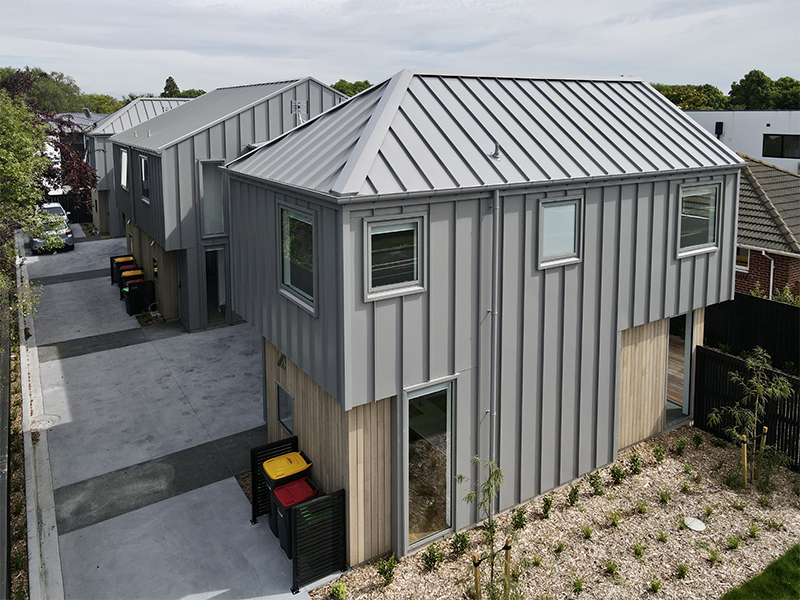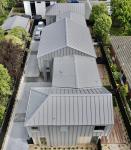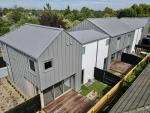St Albans Townhouses

With New Zealanders embracing living in apartments and townhouses, there is a boom in multi-unit housing – and Christchurch is no different.
With that in mind, designer Sam Connell, from Figure & Ground, was engaged to come up with a multi-unit development for a St Albans site that had been cleared of an earthquake-damaged character house.
One of the main focuses was optimising the site coverage while building in sympathy with an area with character homes.
The 613sq m site is zoned Residential Suburban Density Transition Zone, which demands a lower density than the medium density zone. Within the constraints of that zoning and rules around site coverage and recessions planes, Sam designed a plan for four two-storey dwellings of 125sq m with three bedrooms.
Sam says, “The way that we have designed it, the dwellings are basically a mirror image of each other.”
The configuration of the dwellings has the living and kitchen areas as well as garage on the ground level with three bedrooms and a bathroom upstairs. The master bedroom, with en suite and walk-in wardrobe, sits over the garage. The dwellings are separated by inter-tenancy walls that are fire- and acoustic-rated.
Sam says using a gable roof was a given in an area with traditional housing.
“There is lots of character housing in St Albans and a character overlay nearby that runs down to Rugby Park so the gable roof form was more in keeping with that traditional style. There is a steeper gable on the main roof, with a lower pitch roof over the garage and master bedroom, and a valley flashing connecting the two roof forms.”
The Heritage Tray roofing and cladding is also in keeping with a more traditional look and is a long-lasting product.
“We specify a lot of tray cladding and roofing in our projects because of its looks, its lifespan and it’s easy to maintain. It’s a good product particularly from a maintenance point of view because you don’t have that requirement for frequent maintenance or to set up scaffolding to do that work.”
“We used the white-plastered walls to break up the tray profile.”
He adds, “With tray profiling it can be tricky to detail around doors and windows to get the standing seam in the right place but that’s the reason we have teamed up with Reads Roofing because you have a good idea of how they will detail a job and the way they work – plus Aaron is quite a craftsman when it comes to that.”
Roofer Aaron Read, of Reads Roofing, says that he enjoys the technical side of planning out roofing and particularly cladding, which is what people can easily see and critique.
“The best practice for laying out cladding is not always what’s drawn – it’s better to sit down with the designer, the owner and the builder and talk the job through,” he says.
“With this job, we wanted to have the ribs of the roof and the cladding line up perfectly so we had to reverse engineer it so we could lay the roof in line with the walls. Tray looks very simple but it is challenging to make it look effortless.”
Aaron said having a good relationship with Dimond Roofing meant he could achieve the level of detail he wanted in a timely fashion so the project wasn’t held back.
“The ground floor had folded corners in the doorway areas so that meant having to lay up to the door, measure the sheet then get Dimond roofing to fold the tray in their sheet metal flashing folder. There were There were a significant amount of corners that needed to be individually folded – I was in there every second day for a month getting sheets done but it’s all about communicating what you need done and why then people understand and get on board with it.”
Aaron says there was a lot of problem-solving on the job and liaising with the builders – DP Built – and scaffolders about staging various aspects of the construction.
“On the top storey there’s a negative detail corner flashing, which I actually designed on the job for that job. We tried a new system with no external fixings and no rivets and it worked and looked cool. We had the team from All Steel fabrication use their brake folder to create our nine-fold corner flashing.”
He adds, “There are also some junctions where it goes from tray to cedar and we had to work with the builders so they didn’t clad that part of the wall until we had done our bit.” Sam says he chose the lighter Sandstone Grey colour for the tray profile as it looks better when the sun is shining directly on it. “Some of the darker colours can ‘oil can’ in direct sunlight but the outcome has been good with the Sandstone colour.”
‘Oil canning’ is the visible waviness in the flat areas of metal roofing and walling. Oil canning produces an aesthetic effect inherent in standing seam tray profiles and profiles/flashings with wide flat elements. It is not detrimental to product performance.
It can occur during the forming and installation processes and during thermal expansion of the roof sheeting during its life cycle. The effect can be more or less pronounced depending on differing light and sun angle conditions and the coating gloss levels.
For Heritage Tray, oil canning can be reduced by a vented roof underlay.
There are several options to reduce the oil canning effect in tray-type profiles and flashings, for example:
a) increasing the thickness of the material,
b) using stiffening swages in wide flat elements and
c) limiting flat elements to less than 150mm width.
Figure & Ground
This practice aims to deliver exceptional outcomes backed by an established team and reputation.
“We are a unique combination of local expertise with international experience. You can expect professional advice, but in a language you understand.
“We deliver creative and elegant designs, across a variety of sectors including; residential, multi-residential and later living.
“We are commercially minded and creative thinkers, who translate your ideas into reality.”


